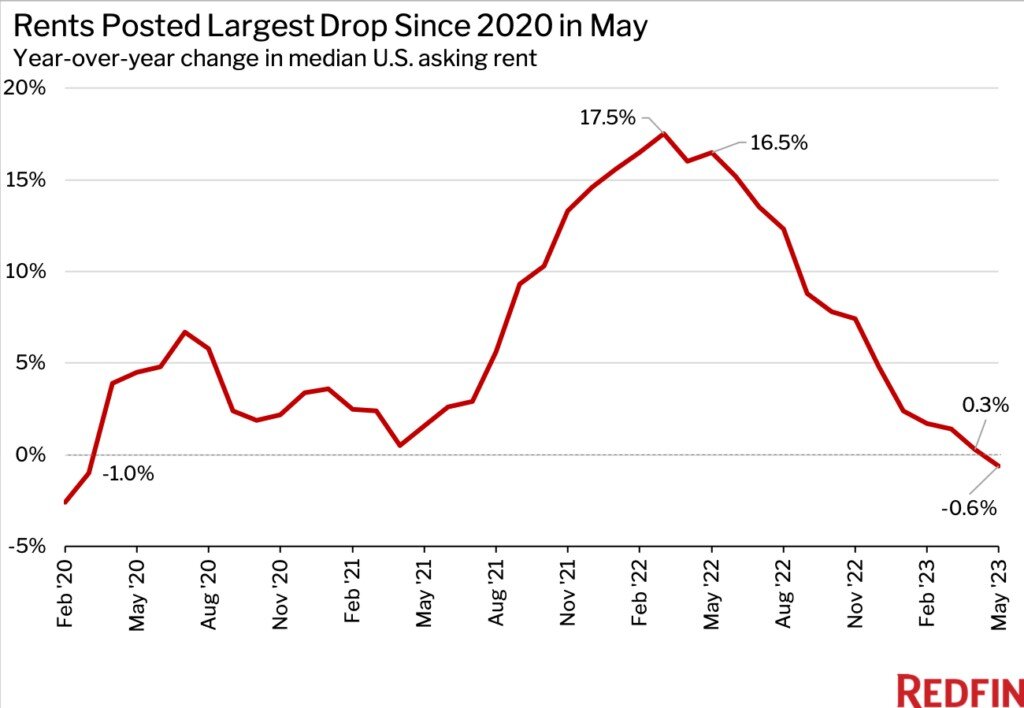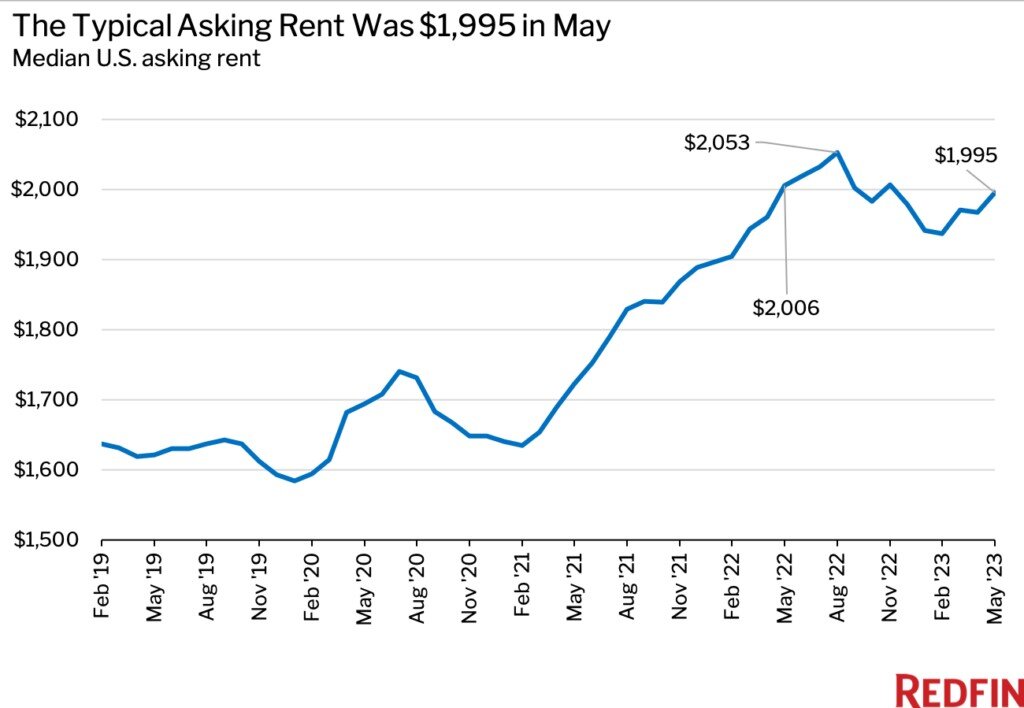Residential Real Estate News

Home Asking Rents Dip in the West, Yet Rise in Eastern U.S.
Residential News » San Francisco Edition | By David Barley | June 13, 2023 9:34 AM ET
According to Redfin, the median U.S. asking rent fell 0.6% year over year to $1,995 in May 2023 -- the largest annual rent decline since March 2020. That compares with a near-record 16.5% increase one year earlier. May's drop also represented the first annual decline since March 2020 on a revised basis. The median asking rent rose 1.4% from a month earlier in May.
In the West, asking rents declined 2.1% from a year earlier--nearly four times the national pace. But other U.S. regions saw increases, with rents climbing 5.4% in the Northeast, 4.9% in the Midwest and 0.8% in the South.
Rents have cooled in part because the number of rentals on the market has grown, giving landlords less leeway to hike prices because they're grappling with a rise in vacancies as renters get more options to choose from.
One reason rental supply has been growing is many homeowners are opting to rent their homes out instead of selling. Some have already moved into their next home, and are renting their previous home out to cash in on still-high rents and continue building equity on a house with a relatively low mortgage payment. The average 30-year-fixed mortgage rate is 6.8%, up from 5.09% a year ago and a record low of 2.65% in January 2021. The average monthly payment is $320 higher than it was at this time last year.
"Many homeowners are deciding that instead of selling, they're going to renovate their current home or rent it out while they wait for the market to improve," said David Orr, a Redfin Premier real estate agent in Sacramento, CA. Some homeowners are likely waiting for housing prices to bounce back so they can make a larger profit when they do sell.
Rental supply has also increased because America has been building more multifamily housing. Completed residential projects in buildings with five or more units rose 24.2% year over year on a seasonally-adjusted basis to 400,000 in April--the most recent month for which data is available. This is likely part of the reason the rental vacancy rate has ticked up; it was 6.4% in the first quarter--the highest level in two years.
While a building boom has driven up the number of rentals on the market, the boom is slowing. The number of permitted residential projects in buildings with five or more units fell 22.9% year over year on a seasonally-adjusted basis to 503,000 in April. Permits, or approvals given by local jurisdictions to start construction projects, are a leading indicator of what's happening in the housing market. Completions are a lagging indicator. Still, there remains a backlog of under-construction rentals that have yet to hit the market, meaning rents likely still have room to fall.
Finally, rents have eased because fewer people are moving due to economic uncertainty, slowing household formation, still-high rental prices in many markets, and the rising cost of other goods and services due to inflation.
While asking rents fell from a year earlier in May, they were still only 2.8% below their August peak of $2,053, meaning many renters are still taking on high rents. That isn't the case in every market, though; in areas where rents are cooling more, renters are more likely to get deals and concessions from landlords.
Rents Are Falling in the West, Rising in the Northeast
In the West, the median asking rent fell 2.1% year over year to $2,409 in May. That's the only region Redfin analyzed that saw an annual decline. Asking rents rose 5.4% to $2,495 in the Northeast, 4.9% to $1,406 in the Midwest and 0.8% to $1,663 in the South.
Rents are cooling fastest in the West and South in part because they rose so much during the pandemic as scores of people moved into places including Phoenix and Miami. Now, rents in those regions have relatively more room to fall as supply catches up with demand. Rent growth has been steadier in the Midwest, which is home to many relatively affordable markets.
The West is also seeing rents decelerate quickly because it is building a lot of multifamily housing, which means landlords in some areas are grappling with rising vacancies. There were 440,000 new non single family homes completed in the West in the first quarter, compared with roughly 200,000 in each of the other three U.S. regions. Expensive West Coast tech hubs like Seattle and San Francisco may also be experiencing rent declines due to remote work and tech layoffs.
Sign Up Free | The WPJ Weekly Newsletter
Relevant real estate news.
Actionable market intelligence.
Right to your inbox every week.
Real Estate Listings Showcase
Related News Stories
Residential Real Estate Headlines
- Las Vegas Area Home Prices Uptick 4.3 Percent Annually in March
- Single-Family Rent Growth in U.S. Trends Upward in 2025
- U.S. Mortgage Rates Tick Down Post Trump Tariffs Commencement
- President Trump's 'Liberation Day' Tariffs Potential Impact on the U.S. Housing and Mortgage Markets
- Baby Boomers Biggest Cohort of U.S. Home Buyers in 2025 as Millennials Decline
- U.S. Monthly Housing Payments Hit Record High in 2025
- U.S. Pending Home Sales Uptick in February
- Global Prime Residential Rent Slowdown Continued in Late 2024
- Ireland Home Price Inflation Hits 8 Year High in Early 2025
- Existing Home Sales in America Uptick in February
- Great Miami Area Residential Sales Decline 15 Percent Annually in February
- Mortgage Rates Uptick in Mid-March, Ending 9-Week Decline in U.S.
- World Property Ventures Builds the Future of Real Estate with New Funding Round
- U.S. Builder Sentiment Declines Amid Economic Uncertainty and Rising Costs
- Black Homeownership Rates in U.S. Enjoy Largest Annual Increase of All Racial Groups
- Wealthy Renters Are Taking Over More of the U.S. Rental Market
- If U.S. Congress Does Not Extend NFIP Soon, Thousands of Daily Home Closings Impacted
- U.S. Mortgage Applications Spike 11 Percent in Early March
- Greater Palm Beach Area Residential Sales Rise in Early 2025
- New Apartments in U.S. Are Leasing at Slowest Pace on Record
- U.S. Mortgage Rates Drop to 4 Month Low in March
- Overall U.S. Mortgage Delinquency Rates Dip in December
- New Tariffs on Canada, Mexico to Impact U.S. Homebuilder Input Costs
- Monaco's Property Market: A Tale of Two Cities
- U.S. Home Purchase Cancellations Surge, 1 in 7 Sales Getting Canceled
- U.S. Pending Home Sales Hit Historic Low in Early 2025
- Greater Miami Area Residential Sales Dip in January
- Governor DeSantis Supports Ending Property Taxes in Florida
- WPV Aims to Become the Berkshire Hathaway of Real Estate Tech
- U.S. Home Sales Slump Continues in January
- Average Americans Spend 38 Percent of Monthly Income on Mortgage Payments
- Switzerland's Safe-Haven Appeal Grows with World's Wealthy Homebuyers
- U.S. Builder Confidence Rapidly Declines in February
- Las Vegas Home Sales Rise 6.7 Percent Annually in January, Condo Sales Dip
- Homebuyer Demand in America Drops to 5-Year Low in Early 2025
- Ownership More Affordable Than Renting in Most U.S. Markets
- The World's First Global Listings Service Launches, Called a GLS
- Home Prices Continue to Rise in 89 Percent of U.S. Metros in Late 2024
- Global Luxury Residential Prices Showed Gradual Improvement in Late 2024
- U.S. Construction Hiring Rate Drops to Lowest Levels in 5 Years







